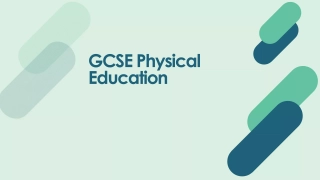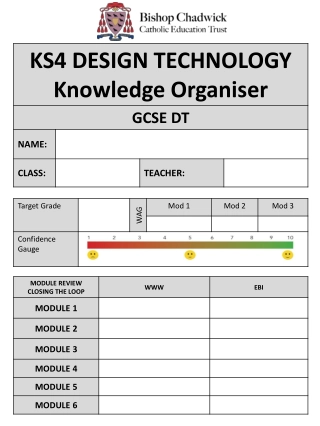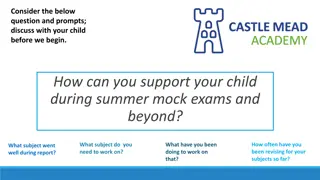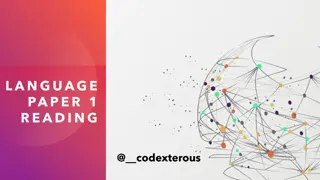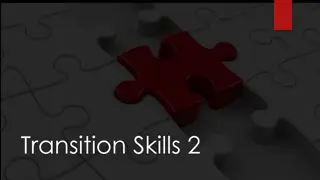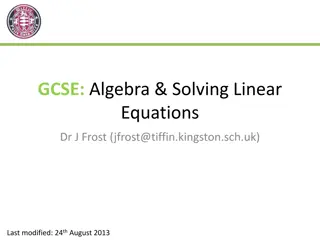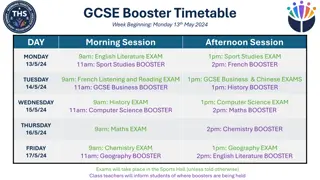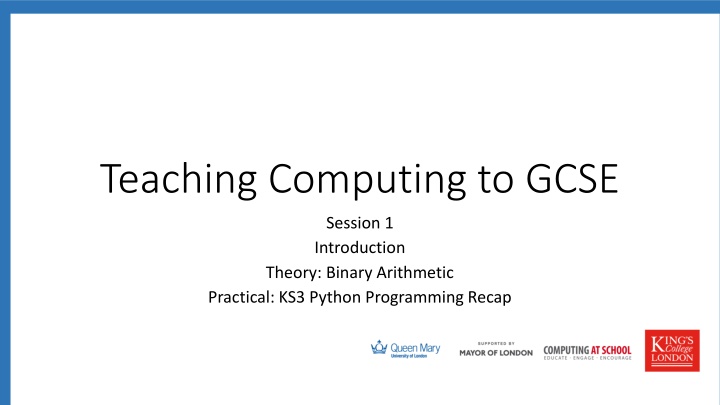
Teaching Computing: Binary Arithmetic and Python Programming Overview
This session introduces GCSE students to binary arithmetic theory and practical Python programming skills. Topics covered include adding binary numbers, binary shifts, logic diagrams, CPU architecture, arrays, and more. Prepare for GCSE programming with longer tasks and consolidate understanding through practice. Understand how computers represent numbers, perform binary arithmetic, and handle overflow. Learn the basics of negative numbers representation in binary.
Download Presentation

Please find below an Image/Link to download the presentation.
The content on the website is provided AS IS for your information and personal use only. It may not be sold, licensed, or shared on other websites without obtaining consent from the author. If you encounter any issues during the download, it is possible that the publisher has removed the file from their server.
You are allowed to download the files provided on this website for personal or commercial use, subject to the condition that they are used lawfully. All files are the property of their respective owners.
The content on the website is provided AS IS for your information and personal use only. It may not be sold, licensed, or shared on other websites without obtaining consent from the author.
E N D
Presentation Transcript
Teaching Computing to GCSE Session 1 Introduction Theory: Binary Arithmetic Practical: KS3 Python Programming Recap
Course Outline Computing Theory (5:00 6:00) Programming in Python (6:00 7:30) Binary arithmetic Python programming KS3 recap Truth tables/logic diagrams For loops and while loops CPU Architecture 1-D & 2-D arrays (lists) The internet & protocols Tracing and pseudocode Cybersecurity Functions & parameters Searching algorithms Exception handling and debugging Sorting algorithms Testing programs High level/low level languages File handling & CSV files Consolidation: Programming for GCSE with longer tasks Consolidation: Programming for GCSE with longer tasks
Specification Content OCR How to add two 8 bit binary numbers and explain overflow errors which may occur Binary shifts AQA Be able to add together up to three binary numbers Be able to apply a binary shift to a binary number Describe situations where binary shifts can be used Edexcel Understand how computers represent and manipulate numbers (unsigned integers, signed integers (sign and magnitude, two s complement)) Understand how to perform binary arithmetic (add, shifts (logical and arithmetic)) and understand the concept of overflow
Binary Recap Each place in a binary number has a value. These values go up in multiples of 2. 128 0 64 0 32 0 16 1 8 0 4 1 2 0 1 0 16 + 4 = 20 We convert a binary number to decimal (aka denary) by adding the place values of the columns that contain a 1.
Binary Addition Recap For the AQA specification you need to be able to add together up to three binary numbers. 1 0 0 0 1 1 1 1 0 1 1 0 0 1 0 1 1 1 0 1 0 1 0 0 1 1 1 1 1 0 Rules: 0+1 = 1 1+1 = 10 (write down 0, carry 1) 1+1+1 = 11 (write down 1, carry 1) 1+1+1+1 = 100 (write down 0, carry 0, carry 1) 1 1 0 0 0 0 0 0
Negative Numbers There are two different methods of representing negative numbers in binary: Sign and Magnitude Two s Complement In both systems the most significant bit is known as the sign bit .
Sign and Magnitude Sign and magnitude is the simplest way of representing negative numbers in binary. In sign and magnitude the sign bit doesn t have a value, it simply tells us whether the number is positive or negative. 0 = plus (+) 1 = minus (-) Sign 1 64 0 32 0 16 1 8 0 4 1 2 0 1 0 = -20
Activity 1a Convert the following binary numbers that use sign and magnitude representation to decimal. Sign 1 0 1 0 64 1 1 0 1 32 0 0 1 1 16 0 0 1 1 8 0 0 1 1 4 0 0 0 1 2 0 0 1 1 1 0 1 0 1 Decimal
Activity 1b Convert the following decimal numbers to binary numbers that use sign and magnitude representation to decimal. Use paper for working out. Decimal -73 -91 46 102 Sign 64 32 16 8 4 2 1
The Problem with Sign and Magnitude Sign and magnitude might be simple, however it causes problems when performing binary addition. Two s complement is an alternative method of representing negative binary numbers that works with binary addition.
Twos Complement In two s complement the sign bit is a negative number. -128 1 64 1 32 1 16 0 8 1 4 1 2 0 1 0 Just like a normal binary number, we convert it to decimal by adding the place values together. -128 + 64 + 32 + 8 + 4 = -20
Flipping the Bits We can easily work out the positive equivalent of a negative two s complement number using the flipping the bits method. 128 1 0 0 64 1 0 0 32 1 0 0 16 0 1 1 8 1 0 0 4 1 0 1 2 0 1 0 1 0 1 0 Original Number Flip the bits Add 1 = 20 = -20 Finally we add a minus sign, as the original number is negative.
Activity 2a Convert the following binary numbers that use two s complement representation to decimal. Sign 1 0 1 1 64 1 1 0 1 32 1 0 1 1 16 0 0 1 1 8 0 1 1 1 4 0 0 0 1 2 0 0 1 1 1 0 1 0 1 Decimal
Activity 2b Convert the following decimal numbers to binary numbers that use two s complement representation to decimal. Use paper for working out. Decimal -73 -91 46 102 Sign 64 32 16 8 4 2 1
Logical Shift Logical shift can be used to easily multiply and divide number by powers of 2. A logical left shift of 1 multiplies the number by 2. A logical right shift of 1 divides the number by 2. We pad out any empty places with 0s. 128 0 0 0 64 0 0 0 32 0 0 0 16 1 1 1 8 0 0 0 4 0 0 0 2 0 0 0 1 0 0 0 0 0 0 0 1 0 0 0 0 1 0 0 0 0 0 0
Activity 3 a) Perform a logical left shift of 1 on this number. 128 64 32 16 8 4 2 1 Decimal Original 0 0 0 0 1 1 0 0 Shifted a) Perform a logical left shift of 2 on this number. 128 64 32 16 8 4 2 1 Decimal Original 0 0 0 0 1 0 0 1 Shifted
Activity 4 a) Perform a logical right shift of 1 on this number. 128 64 32 16 8 4 2 1 Decimal Original 0 0 1 1 0 0 0 0 Shifted a) Perform a logical right shift of 2 on this number. 128 64 32 16 8 4 2 1 Decimal Original 1 0 0 0 1 0 0 0 Shifted
Shifting Signed Integers Logical shift won t work with negative numbers represented in two s complement binary. When we shift the number to the right we loose the sign bit, giving us the wrong result. -128 1 0 64 0 1 32 0 0 16 1 0 8 0 1 4 0 0 2 0 0 1 0 0 = -112 = 72 1 0 0 1 0 0 0 0
Arithmetic Shift Arithmetic shift solves the problem of shifting a negative two s complement to the right. With arithmetic shift, when shifting a number to the right we pad out the empty spaces with a copy of the sign bit. -128 1 1 64 0 1 1 32 0 0 16 1 0 8 0 1 4 0 0 2 0 0 1 0 0 = -112 = -56 1 0 0 1 0 0 0 0 When shifting to the left we still fill the empty places with 0s.
Activity 5 a) Perform an right arithmetic shift of 1 on this two s complement number. -128 64 32 16 8 4 2 1 Decimal Original 1 0 1 1 0 0 0 0 Shifted a) Perform a right arithmetic shift of 2 on this two s complement number. -128 64 32 16 8 4 2 1 Decimal Original 0 0 0 1 1 0 0 0 Shifted
Activity 6 a) Perform an left arithmetic shift of 1 on this two s complement number. -128 64 32 16 8 4 2 1 Decimal Original 0 0 1 0 1 0 0 0 Shifted a) Perform a left arithmetic shift of 2 on this two s complement number. -128 64 32 16 8 4 2 1 Decimal Original 0 0 0 1 1 0 1 1 Shifted
Break After the break we will recap Python Programming for KS3

